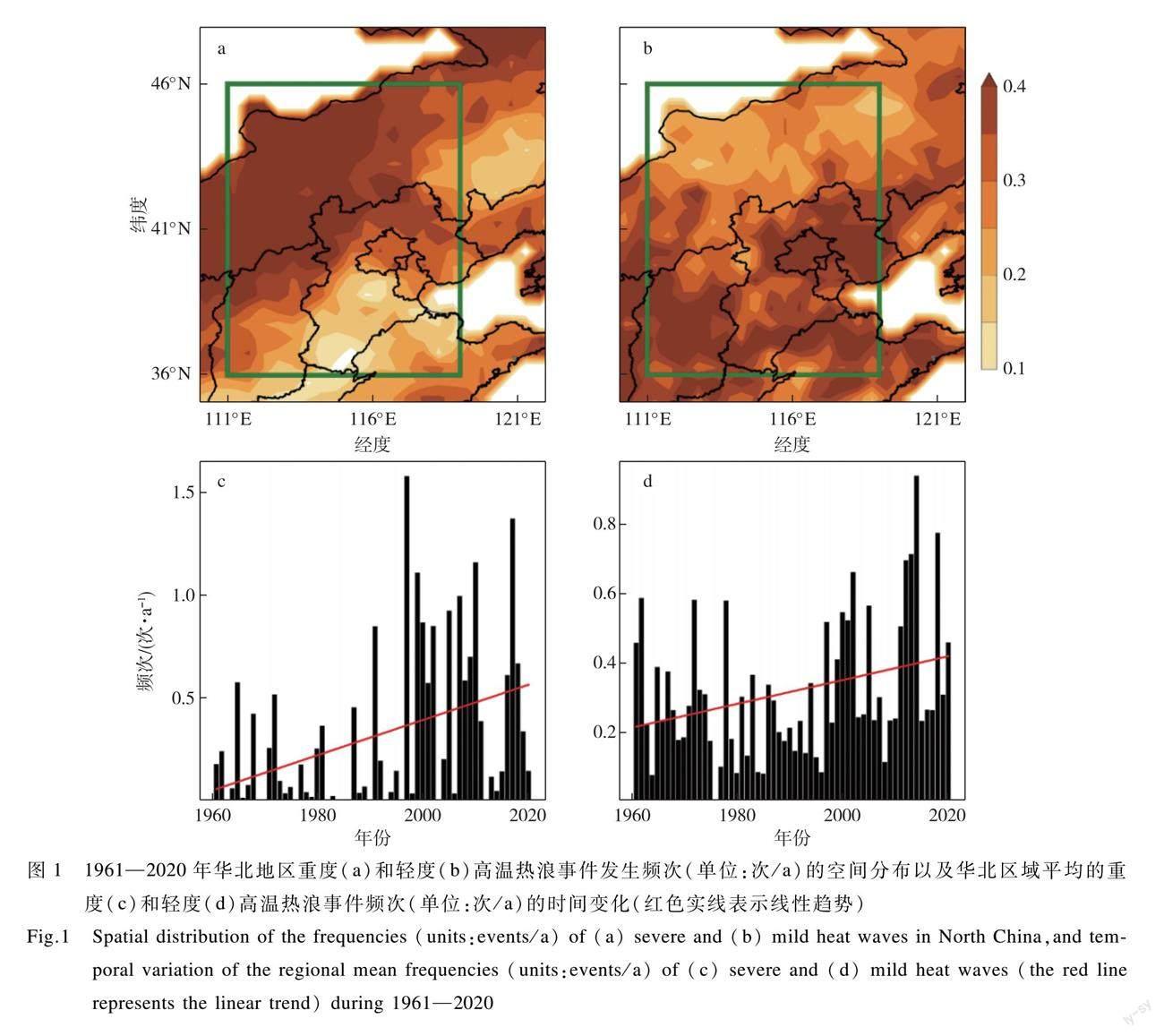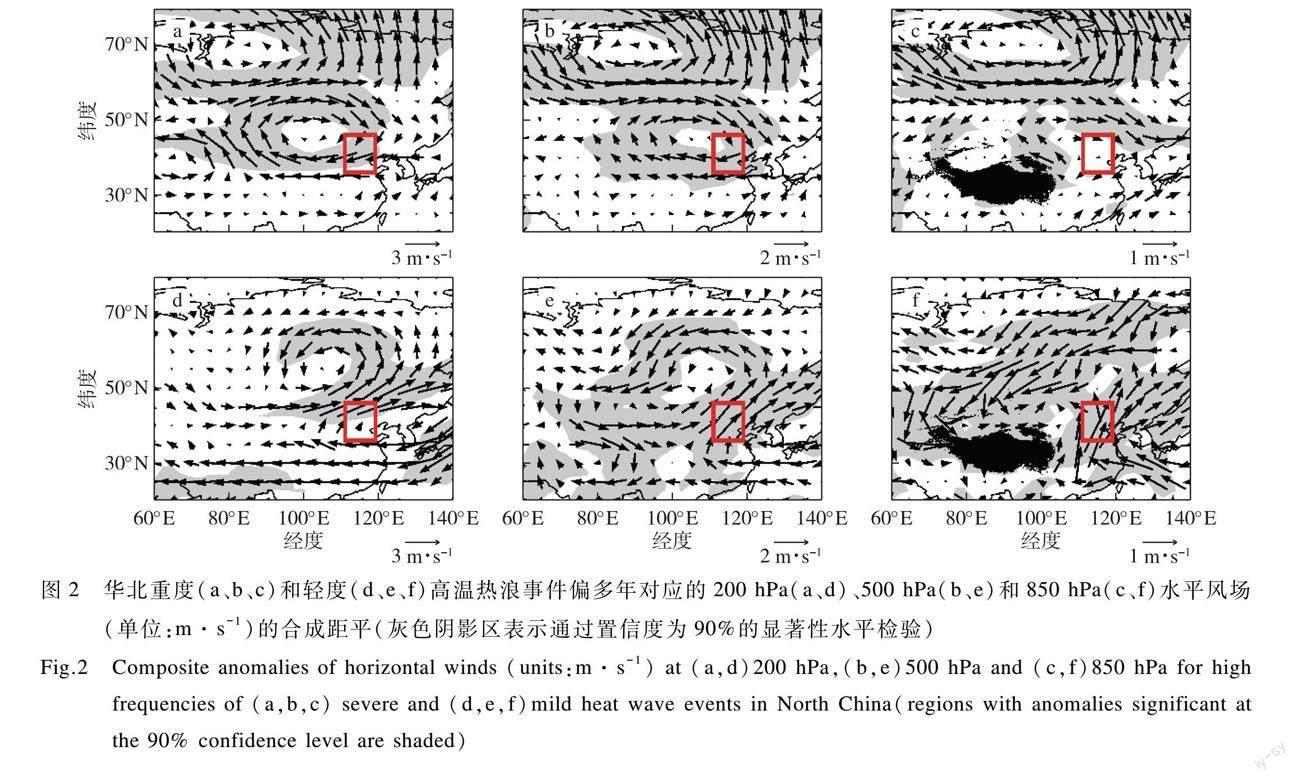影响华北重度和轻度高温热浪的大气背景场差异分析
2024-04-25靳鑫桐周波涛谢文欣胡跃鹏范怡
靳鑫桐 周波涛 谢文欣 胡跃鹏 范怡



摘要 首先识别了1961—2020年华北地区的高温热浪事件,在此基础上筛选出重度和轻度高温热浪事件多发年份,对比分析了重度和轻度高温热浪事件的时空变化特征以及大气背景差异。结果表明,重度和轻度高温热浪发生频次的高值区分别位于华北北部和中南部。自20世纪60年代以来,华北重度和轻度高温热浪事件频次均呈现显著的增长趋势,其中重度高温热浪事件频次的增加更为明显。对应华北重度高温热浪事件多发,东亚中纬度地区为准相当正压结构的异常反气旋性环流控制,华北地区位于异常反气旋性环流的东南部。在该异常环流背景下,华北地区上空呈现异常下沉运动、云量偏少、大气整体偏干。在异常下沉绝热增温的同时,晴朗干燥的配置有利于更多的太阳辐射到达地表,相应的向上长波辐射和感热通量增加,进一步加热近地表大气。在华北轻度高温热浪事件高发年,华北位于异常反气旋(东南侧)和气旋(西北侧)性环流之间,主要受异常西南风控制。异常西南风向华北输送暖平流加热大气的同时,增加了华北上空的水汽。偏多的水汽捕获更多的长波辐射并反射至地表,利于气温升高。
關键词重度高温热浪;轻度高温热浪;华北;大气背景;动力水汽条件;热力条件
近几十年来,全球地表平均温度显著升高。据政府间气候变化专门委员会(IPCC)第六次评估报告(AR6),2011—2020年全球地表平均温度相较工业化前增暖约1.09 ℃(IPCC,2021)。在全球变暖大背景下,极端天气气候事件趋多趋强(周波涛和钱进,2021)。特别是极端高温事件发生频次和强度自20世纪50年代以来明显增加(IPCC,2021),对人体健康、生态环境、经济发展等方面造成重要影响(Dunne et al.,2013;Porfiriev,2014;Orlov et al.,2019;Ebi et al.,2021)。
高温热浪是极端高温事件的典型代表之一,一般指的是连续3 d及以上的异常高温过程。研究表明,中国区域的高温热浪事件在全球变暖背景下发生得更加频繁,且愈发严重(Ding et al.,2010;You et al.,2011;Wang et al.,2017;Tao and Zhang,2019;Ren et al.,2020;Xie et al.,2020;高焕妍等,2023;孙博等,2023)。其中,20世纪90年代后华北地区高温热浪的增加更为明显,尤其是强度更强、持续时间更长的高温热浪事件,1997年后超过一半的站点都经历了极端热浪的显著增多(Qian and Lin,2004;Xie et al.,2020;邢佩等,2020)。华北地区人口众多、经济发达,因此,该区域人口和社会经济对高温热浪的暴露程度高,其遭受高温热浪的风险也大(张蕾等,2016;李柔珂等,2020)。鉴于此,开展华北高温热浪变化与机理研究十分必要。
目前,对华北高温热浪的发生机制已有不少研究。卫捷等(2004)揭示华北高温对应西太平洋副热带高压位置偏东:一是西太平洋副热带高压偏东时西风带大槽也偏东,有利于西部的大陆高压东移控制该地区,导致异常下沉运动和绝热增温;二是西太平洋副热带高压东移造成水汽通道东移,输送到华北地区的水汽因而减少,空气干燥,促使温度上升。Chen and Lu(2015)基于合成分析的研究指出,华北东部地区极端高温对应的大气环流异常为典型的热带外型,伴随异常反气旋环流和下沉运动,造成几乎整个对流层增温。Xie and Zhao(2023)对导致华北极端高温发生的天气型进行了分类研究,发现位于中国东北部的反气旋环流异常是最有利于华北高温发生的环流型,而来自大气的欧亚遥相关和来自海洋的维多利亚模态则是有利华北高温天气型出现的主要驱动因子。Sun(2012)的研究表明,夏季北大西洋涛动负位相可引起东亚中部反气旋环流异常,进而导致华北高温日数增多。除大气环流异常的作用外,陆气耦合作用下的局地热量反馈也在一定程度上影响高温热浪的发生(Wang et al.,2019;Xu et al.,2019;Yao et al.,2020)。
不过,现有的研究大多基于全部高温热浪事件的分析或针对典型极端个例,缺乏对不同类型、不同强度高温热浪事件的对比研究。Chen et al.(2023)分析了华北地区日间高温热浪、夜间高温热浪和日夜复合型高温热浪所对应的环流异常,发现这三种不同类型高温热浪的发生与上游波列影响下西风急流和西太平洋副热带高压的位置不同有关。由于不同严重程度的高温热浪事件所带来的影响明显不同,所以也应分开考虑。然而,目前对不同严重程度高温热浪发生的环流背景尚不清楚。
高温热浪强度是判定事件严重程度的关键指标。以往研究多直接采用单一指标对高温热浪的强度进行度量和分类。例如,贾佳和胡泽勇(2017)利用高温日持续时间的长短确定高温热浪等级,分析了中国区域不同强度高温热浪的时空分布特征和区域间的差异。近年来,越来越多的研究开始关注高温热浪事件的综合强度,采用同时考虑温度、湿度等变量的人体舒适度指标(如体感温度,通用热气候指数等)(Luo and Lau,2019;林卉娇,2022),同时考虑夜晚温度和升温幅度的超热因子等(肖安和周长艳,2017)划分高温热浪事件的强度。除了考虑多个变量的异常状况,Russo et al.(2015)提出了同时考虑热浪事件的持续时间和单日强度的HWMId指数,能够对高温热浪的严重程度进行综合度量,已被广泛应用于全球和区域高温热浪研究中(Zampieri et al.,2016;Dosio,2017;Xie et al.,2020,2021)。本文基于HWMId指数,首先对华北高温热浪事件的严重程度进行度量,在此基础上筛选出重度和轻度热浪事件发生的典型年份,对不同综合强度的高温热浪事件发生的可能成因进行探究,并进一步对比二者的异同,旨在深化对华北高温热浪机理过程的理解,为华北地区应对极端高温灾害提供科学支撑。
1 数据与方法
1.1 资料
采用中国区域格点化的CN05.1逐日最高气温数据,水平分辨率为0.25°×0.25°(吴佳和高学杰,2013)。该数据由中国区域2 400多个气象站资料经“距平逼近”方法插值而成,并经过均一化处理。所用的再分析资料来自美国国家环境预报中心/大气研究中心(NCEP/NCAR),水平分辨率为2.5°×2.5°(Kalnay et al.,1996)。分析变量包括水平风场、垂直速度、比湿、云量、土壤湿度、净短波辐射、净长波辐射、感热通量和潜热通量。华北地区定义为111°~119°E、36°~46°N的区域,研究时段为1961—2020年,关注季节为夏季6—8月。
1.2 高温热浪识别
本文采用相对阈值定义高温热浪事件,即定义每个日期下参考时段(1961—1990年)前后15 d滑动窗口(30×31=930 d)的第90分位数为对应日期的高温阈值,具体计算如下(Xie et al.,2020):
Ad=∪1990y=1961∪i=d+15i=d-15Ty,i。
其中:Ty,i指第y年的第i天的日最高气温;∪指取并集,每个格点都有一个对应的集合Ad。若某日的日最高气温超过对应日期下的阈值则定义为一个高温日,若出现连续3 d及以上的高温日则定义为一次高温热浪事件。
在识别高温热浪事件的基础上,采用HWMId指数(Russo et al.,2015)衡量高温热浪事件的综合强度,计算公式如下:
Md(Td)=Td-T30y25pT30y75p-T30y25p, Td>T30y25p;
0,Td≤T30y25p。
其中:Td指高温热浪事件中第d天的日最高气温;T30y25p和T30y75p分别指某格点参考时段内夏季日最高气温的25%分位数和75%分位数;Md代表高温日“异常程度”与“一般状况”的比值。将一次高温热浪事件中高溫日的Md总和定义为HWMId指数,可以同时衡量高温热浪事件的持续时间和单日强度。
本文根据参考时期1961—1990年华北地区高温热浪事件的发生情况,对事件的严重程度进行划分。具体的划分方法为:以华北所有高温热浪事件综合强度(HWMId值)的75%分位值和25%分位值作为标准,将HWMId>7.96(75%分位值)的高温热浪事件定义为重度高温热浪事件,将HWMId<4.46(25%分位值)的高温热浪事件定义为轻度热浪事件。
1.3 统计分析方法
本文主要采用合成分析方法探讨重度高温热浪和轻度高温热浪对应的大气背景场的差异,统一选取1961—2020年作为气候态平均值,并采用Students t方法对异常状况进行显著性检验。为消除全球变暖信号的影响,本文在选取重度和轻度高温热浪偏多年以及进行合成分析时,均对要素场作了去趋势处理。
2 结果分析
2.1 重度和轻度高温热浪事件的时空分布特征
图1给出了1961—2020年华北地区重度和轻度高温热浪事件发生频次的空间分布和时间演变。从空间分布来看,重度高温热浪事件高发区主要位于华北北部,即内蒙古中部地区,平均发生频次大多超过0.4次/a(图1a);而轻度高温热浪事件多发于华北中南部,即京津冀、山西东部和山东北部地区(图1b)。就整个华北区域平均而言,1961—2020年重度高温热浪与轻度高温热浪事件分别平均发生0.32次/a和0.31次/a
从时间变化来看,重度高温热浪和轻度高温热浪事件的发生频次均呈现显著的增加趋势。其中,重度高温热浪事件发生频次的增加速率为0.09次/(10 a)(通过95%置信水平检验,图1c),大于轻度高温热浪事件发生频次的增加速率(0.03次/(10 a),通过95%置信水平检验,图1d)。此外,重度和轻度高温热浪频次还呈现明显的年代际变化特征。重度高温热浪表现为20世纪90年代末期前频次偏少,之后频次明显偏多(图1c);而轻度高温热浪的频次则整体呈现多-少-多的特征,转折点大致位于20世纪70年代末期和90年代末期(图1d)。
2.2 大尺度环流背景
为探讨华北重度和轻度高温热浪事件对应的环流背景,本文根据华北区域平均的高温热浪频次时间序列,对重度和轻度高温热浪事件发生的典型年份进行筛选。为去除全球变暖信号的影响,我们先对时间序列进行去趋势处理,然后再标准化。在此基础上,将重度(轻度)高温热浪频次标准化值大于1的年份定义为重度(轻度)高温热浪多发年。为避免信号损失,若某一年重度和轻度高温热浪发生频次的标准化值均超过1且两者差异较小,则剔除该年;若二者都超过1,但重度(或轻度)高温热浪标准化值明显偏大,则对该年予以保留并作为重度(或轻度)高温热浪事件多发年。基于此原则,分别筛选出华北重度和轻度高温热浪事件偏多年份各7 a。重度高温热浪事件偏多的典型年份为1965,1991,1997,1999,2007,2010和2017年;轻度高温热浪事件偏多的典型年份为1961,1962,1978,2012,2013,2014和2018年。
图2为华北重度和轻度高温热浪偏多年对应的异常水平风场。可见,华北重度高温热浪事件偏多时(图2a—c),东亚中纬度地区上空存在显著的反气旋性环流异常,在其西北侧的高纬度地区则为异常的气旋性环流控制,呈现偶极分布型。该环流异常分布从对流层高层到低层均可见,表现出准相当正压结构。华北地区位于异常反气旋性环流的东南部,主要受异常东北风和东风控制。对应轻度高温热浪事件高发年(图2d—f),偶极型环流异常同样存在于对流层,但相较于重度高温热浪事件多发年份,其位置要偏东偏南。华北地区位于异常反气旋环流的西北侧,受西南风异常的控制。
2.3 动力和水汽条件
上述重度和轻度高温热浪事件偏多所对应的大尺度环流异常场差异可进一步引起华北上空不同的动力和水汽条件。由图3a可以看到,重度高温热浪偏多时,与高空异常反气旋性环流控制相对应,华北对流层高层散度呈现显著的负异常,意味着大气异常辐合下沉。该异常下沉运动在整个对流层均可清晰地观察到(图3c),表明大气层结处于稳定状态。异常下沉运动将抑制对流活动的发生,因而造成华北上空云量显著偏少(图3e),有利于晴朗天气的出现(张庆云等,2003;卫捷等,2004;尹泽疆等,2023)。
与重度高温热浪事件多发年相比,在华北轻度高温热浪事件多发年份,随着偶极型异常环流位置的偏东偏南,对流层高层异常辐合中心移至华北区域的南侧,华北大部分地区及其东北侧为大气辐散异常(图3b),呈现出异常的上升运动(图3d),不利于华北上空云量的减少(图3f)。
图4显示了与华北重度和轻度高温热浪事件多发相关联的水汽特征。在重度高温热浪事件偏多年,相应于反气旋性环流异常,在华北区域出现异常的北风和东风水汽输送(图4a),指示水汽输送通量异常辐散(图4a),结果导致该区域水汽减少,大气总体偏干(图4c)。与重度高温热浪事件对应的水汽输送特征不同,在轻度高温热浪事件偏多年,受异常偏南风气流的引导,水汽由海洋向华北区域输送(图4b),进而使得华北区域的水汽增多,造成大气总体偏湿(图4d)。
总体来讲,华北重度高温热浪事件和轻度高温热浪事件多发年所对应的动力和水汽条件的配置几乎呈现相反的状况。即重度高温热浪事件多发年,华北区域为异常下沉运动控制,水汽条件偏干;而轻度高温热浪事件偏多年对应华北区域异常上升运动,水汽条件偏湿。
2.4 热力条件
图5分别给出了华北重度和轻度高温热浪事件多发年对应的地表净短波辐射和净长波辐射的合成结果。结果表明,对应于重度高温热浪事件多发年,由于云量(图3e)和水汽(图4c)的减少,华北地区所接收到的净短波辐射增加(图5a),向上的净长波辐射也随之增加(图5c),从而加热近地表大气,使得气温升高。
对于轻度高温热浪事件,由于云量变化不明显(图3f),向下的净长波辐射的变化也不显著,仅呈现出相较于气候态平均略微减小的态势(图5b)。但是,由于水汽的显著增加(图4d),其能同时捕捉和反射更多的长波辐射到达地面,使得向下的凈长波辐射显著偏多(图5d),有利于气温的升高。该结果亦表明水汽在华北轻度高温热浪事件发生中的作用。
此外,重度高温热浪事件多发的典型年,华北地区土壤湿度相对偏干(图6a),土壤水分的缺失导致地表蒸散量减小(Yao et al.,2020)。因此,异常增多的太阳辐射加热地表,使得向上的感热通量增加(图6c),进一步加剧了气温的升高。而对于轻度高温热浪事件偏多年份,由于土壤湿度的偏高(图6b),华北部分地区呈现潜热通量负异常,表明由地面向上的潜热释放增加,也有利于气温的增加(图6f)。
基于热力学能量方程,除了绝热加热和非绝热加热的作用外,温度平流输送对异常增温也具有影响。图7分别给出了华北重度和轻度高温热浪事件多发年对应的850 hPa水平温度平流的合成距平场空间分布。在重度高温热浪事件多发年,温度平流在华北区域的南部和北部分别呈现轻微的负异常和正异常,表明其对重度高温热浪事件的影响较小(图7a);相比而言,在轻度高温热浪事件的多发年份,华北地区上空的温度平流整体呈现正异常,尤其在华北南部较为显著,表明异常偏南风将中低纬的暖湿气流向北输送,有助于华北地区增温(图7b)。
3 结论与讨论
基于CN05.1的日最高气温格点观测资料,本文首先对1961—2020年华北地区高温热浪事件进行识别,并基于综合考虑事件单日强度和持续时间的HWMId指数,度量了高温热浪事件的综合强度。在此基础上,根据华北地区所有高温热浪事件综合强度的75%分位值与25%分位值,筛选出重度和轻度高温热浪事件,并分析了其时空分布特征。进一步地利用再分析资料,探讨了与重度和轻度高温热浪事件相关联的环流背景、水汽特征和热力条件等的异同。主要结论如下:
1)华北地区重度高温热浪事件高发区主要位于华北北部(即内蒙古中部地区),而轻度高温热浪事件高发区则主要分布在华北中南部,包括京津冀、山西东部和山东北部。自20世纪60年代以来,华北区域平均的重度和轻度高温热浪事件均显著增多,增长趋势分别为0.09次/(10 a)和0.03次/(10 a)。在年代际变化方面,重度高温热浪事件在20世纪90年代末期前总体偏少,之后偏多;而轻度高温热浪的频次则整体呈现多-少-多的特征。
2)当华北地区重度高温热浪事件发生频次偏多时,东亚中纬度地区上空为准相当正压结构的异常反气旋性环流控制,华北地区位于异常反气旋性环流的东南部。伴随异常反气旋性环流的出现,华北上空呈现异常下沉运动,造成绝热增温;同时导致云量和水汽偏少,使得更多的太阳辐射到达地表,相应的向上长波辐射和感热通量增加,进一步通过非绝热过程加热近地表大气。共同作用导致高温过程的异常幅度更大,持续时间更长,造成重度高温热浪事件的发生。
3)当华北地区轻度高温热浪事件发生频次偏多时,华北地区的西北和东南侧分别为异常的气旋性环流和反气旋性环流控制,华北地区位于该偶极子型中间,盛行异常西南风。西南风异常使得来自低纬的暖湿气流输送至华北上空,一方面造成华北上空水汽增多,偏多的水汽进一步通过温室效应向下反射更多的长波辐射加热近地表大气;另一方面通过暖平流输送作用加热大气。
总体来看,重度高温热浪的发生受下沉绝热增温、太阳辐射、感热加热的共同作用,表现为干热特征;轻度高温热浪的发生主要受水汽的温室效应和水平温度输送的影响,呈现湿热属性。两者之间存在明显的差异。虽然以往的研究也揭示了异常高压系统以及其对应的异常下沉运动、偏多的太阳辐射等在华北及周边地区高温热浪事件中的重要作用(Chen and Lu,2015;焦敏等,2019;Yao et al.,2020;Zhang et al.,2020;李经纬等,2021;Yang et al.,2021;Xie and Zhao,2023),但这些研究一般未区分高温热浪事件的强度。与本研究结果相比较可以发现,上述的这些背景特征实际上同本文揭示的与重度高温热浪事件相对应的特征相一致,亦即主要反映的是重度高温热浪的发生背景,这也凸显了划分不同强度高温热浪事件分别开展研究的必要性。当然,本文仅从大尺度环流、动力条件、水汽条件、热力条件等角度对华北重度和轻度高温热浪事件的发生机制进行了初探。影响华北重度和轻度高温热浪事件变化的外强迫因子各自有哪些?其中的物理过程和机制又如何?可用于预测重度和轻度高温热浪事件的前期信号有哪些?这些问题还有待进一步深入研究,以增进对华北重度和轻度高温热浪变化机理的认识,并揭示有效的预测信号因子。
參考文献(References)
Chen P,Zeng G,Yang X Y,et al.,2023.Comparison of atmospheric circulation anomalies between daytime and nighttime extreme high temperature in North China[J].Atmosphere,14(3):495.doi:10.3390/atmos14030495.
Chen R D,Lu R Y,2015.Comparisons of the circulation anomalies associated with extreme heat in different regions of eastern China[J].J Climate,28(14):5830-5844.doi:10.1175/JCLI-D-14-00818.1.
Ding T,Qian W H,Yan Z W,2010.Changes in hot days and heat waves in China during 1961—2007[J].Int J Climatol,30(10):1452-1462.doi:10.1002/joc.1989.
Dosio A,2017.Projection of temperature and heat waves for Africa with an ensemble of CORDEX Regional Climate Models[J].Climate Dyn,49(1):493-519.doi:10.1007/s00382-016-3355-5.
Dunne J P,Stouffer R J,John J G,2013.Reductions in labour capacity from heat stress under climate warming[J].Nat Climate Change,3:563-566.doi:10.1038/nclimate1827.
Ebi K L,Capon A,Berry P,et al.,2021.Hot weather and heat extremes:health risks[J].Lancet,398(10301):698-708.doi:10.1016/S0140-6736(21)01208-3.
高焕妍,沈新勇,董伟,等,2023.城市化和西太平洋副热带高压增强对中国复合热浪的协同作用[J].大气科学学报,46(1):119-131. Gao H Y,Shen X Y,Dong W,et al.,2023.The synergy of urbanization and Western Pacific subtropical high intensification on compound heat waves in China[J].Trans Atmos Sci,46(1):119-131.doi:10.13878/j.cnki.dqkxxb.20210311001.(in Chinese).
IPCC,2021.Climate change 2021:the physical science basis.Contribution of Working Group I to the Sixth Assessment Report of the Intergovernmental Panel on Climate Change[R].Cambridge and New York:Cambridge University Press.
贾佳,胡泽勇,2017.中国不同等级高温热浪的时空分布特征及趋势[J].地球科学进展,32(5):546-559. Jia J,Hu Z Y,2017.Spatial and temporal features and trend of different level heat waves over China[J].Adv Earth Sci,32(5):546-559.doi:10.11867/j.issn.1001-8166.2017.05.0546.(in Chinese).
焦敏,李辑,陈鹏狮,等,2019.2018年夏季辽宁异常高温干旱的环流特征及成因[J].大气科学学报,42(4):571-580. Jiao M,Li J,Chen P S,et al.,2019.Analysis of circulation characteristics and cause of anomalous high temperature and drought in summer of 2018 over Liaoning[J].Trans Atmos Sci,42(4):571-580.doi:10.13878/j.cnki.dqkxxb.20190326001.(in Chinese).
Kalnay E,Kanamitsu M,Kistler R,et al.,1996.The NCEP/NCAR 40-year reanalysis project[J].Bull Am Meteorol Soc,77(3):437-472.doi:10.1175/1520-0477(1996)0770437:TNYRP>2.0.CO;2.
李经纬,曾刚,杨效业,等,2021.中国东北夏季极端高温的分类及其与北大西洋海表温度异常的联系[J].大气科学学报,44(2):302-313. Li J W,Zeng G,Yang X Y,et al.,2021.Classification of summer extreme high temperature events in Northeast China and their relationships with sea surface temperature anomalies in North Atlantic[J].Trans Atmos Sci,44(2):302-313.doi:10.13878/j.cnki.dqkxxb.20200322001.(in Chinese).
李柔珂,韓振宇,徐影,等,2020.高分辨率区域气候变化降尺度数据对京津冀地区高温GDP和人口暴露度的集合预估[J].气候变化研究进展,16(4):491-504. Li R K,Han Z Y,Xu Y,et al.,2020.An ensemble projection of GDP and population exposure to high temperature events over Jing-Jin-Ji district based on high resolution combined dynamical and statistical downscaling datasets[J].Climate Change Res,16(4):491-504.doi:10.12006/j.issn.1673-1719.2019.111.(in Chinese).
林卉娇,2022.基于UTCI指数的中国夏季人体舒适度变化特征及未来预估[D].南京:南京信息工程大学. Lin H J,.2022.The variation characteristics and projection of human thermal comfort during summer in China based on UTCI[D].Nanjing:Nanjing University of Information Science & Technology.(in Chinese).
Luo M,Lau N C,2019.Characteristics of summer heat stress in China during 1979—2014:climatology and long-term trends[J].Climate Dyn,53(9):5375-5388.doi:10.1007/s00382-019-04871-5.
Orlov A,Sillmann J,Aaheim A,et al.,2019.Economic losses of heat-induced reductions in outdoor worker productivity:a case study of Europe[J].Econ Disasters Climate Change,3(3):191-211.doi:10.1007/s41885-019-00044-0.
Porfiriev B,2014.Evaluation of human losses from disasters:the case of the 2010 heat waves and forest fires in Russia[J].Int J Disaster Risk Reduct,7:91-99.doi:10.1016/j.ijdrr.2013.12.007.
Qian W,Lin X,2004.Regional trends in recent temperature indices in China[J].Clim Res,27:119-134.doi:10.3354/cr027119.
Ren L W,Zhou T J,Zhang W X,2020.Attribution of the record-breaking heat event over Northeast Asia in summer 2018:the role of circulation[J].Environ Res Lett,15(5):054018.doi:10.1088/1748-9326/ab8032.
Russo S,Sillmann J,Fischer E M,2015.Top ten European heatwaves since 1950 and their occurrence in the coming decades[J].Environ Res Lett,10(12):124003.doi:10.1088/1748-9326/10/12/124003.
孙博,王会军,黄艳艳,等,2023.2022年夏季中国高温干旱气候特征及成因探讨[J].大气科学学报,46(1):1-8. Sun B,Wang H J,Huang Y Y,et al.,2023.Characteristics and causes of the hot-dry climate anomalies in China during summer of 2022[J].Trans Atmos Sci,46(1):1-8.(in Chinese).
Sun J Q,2012.Possible impact of the summer North Atlantic Oscillation on extreme hot events in China[J].Atmos Ocean Sci Lett,5(3):231-234.doi:10.1080/16742834.2012.11446996.
Tao P H,Zhang Y C,2019.Large-scale circulation features associated with the heat wave over Northeast China in summer 2018[J].Atmos Ocean Sci Lett,12(4):254-260.doi:10.1080/16742834.2019.1610326.
Wang P Y,Tang J P,Sun X G,et al.,2017.Heat waves in China:definitions,leadingpatterns,and connections to large-scale atmospheric circulation and SSTs[J].J Geophys Res Atmos,122(20):10679-10699.doi:10.1002/2017JD027180.
Wang P Y,Zhang Q,Yang Y,et al.,2019.The sensitivity to initial soil moisture for three severe cases of heat waves over eastern China[J].Front Environ Sci,7:6675.doi:10.3389/fenvs.2019.00018.
卫捷,杨辉,孙淑清,2004.西太平洋副热带高压东西位置异常与华北夏季酷暑[J].气象学报,62(3):308-316. Wei J,Yang H,Sun S Q,2004.Relationship between the anomaly longitudinal position of subtropical high in the Western Pacific and severe hot weather in North China in summer[J].Acta Meteorol Sin,62(3):308-316.doi:10.3321/j.issn:0577-6619.2004.03.005.(in Chinese).
吴佳,高学杰,2013.一套格点化的中国区域逐日观测资料及与其它资料的对比[J].地球物理学报,56(4):1102-1111. Wu J,Gao X J,2013.A gridded daily observation dataset over China region and comparison with the other datasets[J].Chin J Geophys,56(4):1102-1111.(in Chinese).
肖安,周长艳,2017.基于超热因子的中国热浪事件气候特征分析[J].气象,43(8):943-952. Xiao A,Zhou C Y,2017.Characteristic analysis of the heat wave events over China based on excess heat factor[J].Meteor Mon,43(8):943-952.doi:10.7519/j.issn.1000-0526.2017.08.005.(in Chinese).
Xie T J,Zhao L,2023.Weather pattern conducive to the extreme summer heat in North China and driven by atmospheric teleconnections[J].Environ Res Lett,18(10):104025.doi:10.1088/1748-9326/acfaaf.
Xie W X,Zhou B T,You Q L,et al.,2020.Observed changes in heat waves with different severities in China during 1961—2015[J].Theor Appl Climatol,141(3):1529-1540.doi:10.1007/s00704-020-03285-2.
Xie W X,Zhou B T,Han Z Y,et al.,2021.Projected changes in heat waves over China:ensemble result from RegCM4 downscaling simulations[J].Int J Climatol,41(7):3865-3880.doi:10.1002/joc.7047.
邢佩,楊若子,杜吴鹏,等,2020.1961—2017年华北地区高温日数及高温热浪时空变化特征[J].地理科学,40(8):1365-1376. Xing P,Yang R Z,Du W P,et al.,2020.Spatiotemporal variation of high temperature day and heat wave in North China during 1961—2017[J].Sci Geogr Sin,40(8):1365-1376.doi:10.13249/j.cnki.sgs.2020.08.016.(in Chinese).
Xu B,Chen H S,Gao C J,et al.,2019.Decadal intensification of local thermal feedback of summer soil moisture over North China[J].Theor Appl Climatol,138(3):1563-1571.doi:10.1007/s00704-019-02918-5.
Yang X Y,Zeng G,Zhang S Y,et al.,2021.Relationship between two types of heat waves in northern East Asia and temperature anomalies in Eastern Europe[J].Environ Res Lett,16(2):024048.doi:10.1088/1748-9326/abdc8a.
Yao J X,Sun X G,Tang J P,et al.,2020.Summer regional pentad heat wave in Eastern China and their possible causes[J].Front Earth Sci,8:511.doi:10.3389/feart.2020.598027.
尹泽疆,魏维,杨崧,2023.北大西洋涛动和英国-鄂霍次克海走廊型遥相关对2022年盛夏长江中下游极端高温的影响[J].大气科学学报,46(3):345-353. Yin Z J,Wei W,Yang S,2023.Extreme hot events in the middle and lower reaches of the Yangtze River in peak summer 2022:roles of the North Atlantic Oscillation and the British-Okhotsk corridor pattern[J].Trans Atmos Sci,46(3):345-353.doi:10.13878/j.cnki.dqkxxb.20230116013.(in Chinese).
You Q L,Kang S C,Aguilar E,et al.,2011.Changes in daily climate extremes in China and their connection to the large scale atmospheric circulation during 1961—2003[J].Climate Dyn,36(11):2399-2417.doi:10.1007/s00382-009-0735-0.
Zampieri M,Russo S,diSabatino S,et al.,2016.Global assessment of heat wave magnitudes from 1901 to 2010 and implications for the river discharge of the Alps[J].Sci Total Environ,571:1330-1339.doi:10.1016/j.scitotenv.2016.07.008.
Zhang G W,Zeng G,Li C,et al.,2020.Impact of PDO and AMO on interdecadal variability in extreme high temperatures in North China over the most recent 40-year period[J].Climate Dyn,54(5):3003-3020.doi:10.1007/s00382-020-05155-z.
张蕾,黄大鹏,杨冰韵,2016.RCP4.5情景下中国人口对高温暴露度预估研究[J].地理研究,35(12):2238-2248. Zhang L,Huang D P,Yang B Y,2016.Future population exposure to high temperature in China under RCP4.5 scenario[J].Geogr Res,35(12):2238-2248.(in Chinese).
张庆云,卫捷,陶诗言,2003.近50年华北干旱的年代际和年际变化及大气环流特征[J].气候与环境研究,8(3):307-318. Zhang Q Y,Wei J,Tao S Y,2003.The decadal and interannual variations of drought in the Northern China and association with the circulations[J].Climate Environ Res,8(3):307-318.doi:10.3969/j.issn.1006-9585.2003.03.005.(in Chinese).
周波涛,钱进,2021.IPCC AR6报告解读:极端天气气候事件变化[J].气候变化研究进展,17(6):713-718. Zhou B T,Qian J,2021.Changes of weather and climate extremes in the IPCC AR6[J].Climate Change Res,17(6):713-718.doi:10.12006/j.issn.1673-1719.2021.167.(in Chinese).
·ARTICLE·
Discrepancy in atmospheric background influencing severe and mild heat wave events over North China
JIN Xintong,ZHOU Botao,XIE Wenxin,HU Yuepeng,FAN Yi
Collaborative Innovation Center on Forecast and Evaluation of Meteorological Disasters,Key Laboratory of Meteorological Disaster,Ministry of Education/Joint International Research Laboratory of Climate and Environment Change,Nanjing University of Information Science & Technology,Nanjing 210044,China
Abstract A heat wave defined as several consecutive days with positive temperature anomalies.Since the 1950s,heat waves have increased in number and intensified globally,exerting significant impacts on human health,theecosystem,and the social economy.The increase in heat waves,especially extreme events with longer duration and higher amplitude over North China after the late 1990s,is of particular note.However,relevant existing studies have mainly focused on unsorted events or typical cases,and the atmospheric backgrounds of heat waves with different severities are unclear.Therefore,using the CN05.1 daily maximum temperature and NCEP/NCAR reanalysis data for the period of 1961—2020,this study identifies severe and mild heat wave events over North China,then selects the years with high frequencies of such events.On this basis,the spatiotemporal variation and atmospheric background of severe and mild heat waves events over North China are investigated through composite analysis.The results show that high frequencies of severe and mild heat wave events mainly appear in the northern part and the middle and southern parts of North China,respectively.For both types of events,their frequencies averaged over North China have shown a significant increasing trend since the 1960s,with a higher occurrence rate of severe heat waves (0.09 events per decade) than mild ones (0.03 events per decade).Corresponding to high frequencies of severe heat waves in North China,an anomalous anticyclonic circulation with the quasi-equivalent barotropic structure dominates the mid-latitudes of East Asia,and the North China domain is located in its southeast flank.Against this background,anomalous subsidence and hence reduction of cloud cover and humidity appear in North China.In addition to the adiabatic heating of the subsidence,the clear-dry air over North China is conducive to stronger solar radiation reaching the land surface.Accordingly,the outgoing longwave radiation and sensible heat from the land surface are enhanced,thus warming the overlying atmosphere over the region.Incomparison,associated with high frequencies of mild heat wave events in North China is an anomalous dipole pattern with the anticyclonic and cyclonic anomalies respectively residing on the southeast and northwest sides of North China,and the target region is under the control of southwesterly anomalies.The southwesterly anomaly can heat the atmosphere through warm advection transport toward North China.At the same time,it also increases humidity over North China by transporting water vapor from the ocean to the region.The increased humidity may capture and reflect more longwave radiation onto the surface,thus favoring the warming of overlying atmosphere.Ingeneral,the occurrence of severe heat waves is affected by the joint contribution of adiabatic heating due to abnormal subsidence,solar radiation and sensible heating,exhibiting a dry-hot nature.The occurrence of mild heat waves is dominated by the greenhouse effect induced by abundant water vapor,and horizontal temperature advection,exhibiting a wet-hot nature.There is a discernible difference in the atmospheric background of severe and mild heat waves.
Keywords severe heat waves;mild heat waves;North China;atmospheric background;dynamic and moisture conditions;thermal conditions
doi:10.13878/j.cnki.dqkxxb.20231220010
(責任编辑:刘菲)
